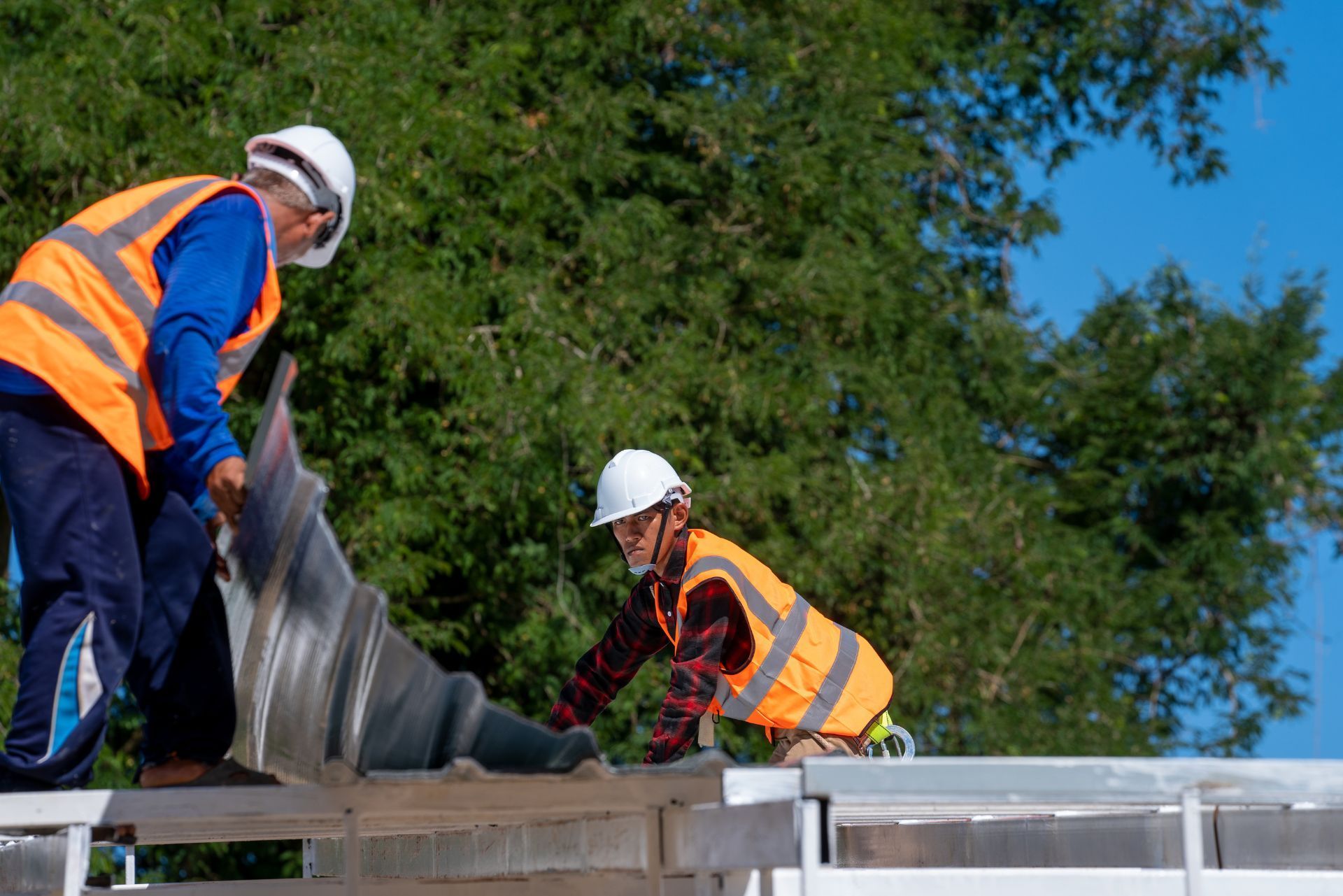Top 3 Recommended Policies

Roofing contractors in New York face a unique set of challenges that go beyond just the physical demands of the job. From unpredictable weather to rising insurance claims, understanding the insurance landscape is crucial before starting any project. The industry is currently navigating a period of change, with roofing-related claims hitting new highs and insurers adjusting their risk assessments accordingly. For those in the business, knowing what coverage to secure and why it matters can make the difference between a smooth project and a costly setback.
Understanding the Roofing Industry Landscape in New York
The roofing contractors industry in New York is projected to decline slightly, with annualized decreases leading to a market size of approximately $1.5 billion by 2025. This contraction is accompanied by a reduction in the number of industry establishments, expected to fall to around 3,277 locations. While this might suggest a cooling market, the demand for roofing services remains steady, especially as weather-related damage becomes more frequent and severe.
Nationally, the roofing industry generates about $52 billion in revenue annually, reflecting its importance across the United States. However, New York’s market dynamics are shaped by local factors such as climate, urban density, and regulatory requirements. These elements influence not only the volume of work but also the risks contractors face on each job.
For roofing businesses, this environment means a careful approach to risk management is essential. Insurance plays a critical role in protecting against the financial fallout from accidents, property damage, and liability claims. Without proper coverage, even a single claim can jeopardize a company’s future.
In addition to the challenges posed by market contraction, roofing contractors in New York must navigate a complex web of regulations and building codes that vary by municipality. These regulations can dictate everything from the types of materials that can be used to the methods of installation, which can significantly impact project timelines and costs. As urban areas continue to grow and evolve, contractors must stay informed about changes in legislation that could affect their operations, making ongoing education and compliance a critical aspect of their business strategy.
Moreover, the increasing emphasis on sustainability and energy efficiency is reshaping the roofing landscape. Many homeowners and businesses are now seeking eco-friendly roofing options, such as green roofs or solar panel installations, which not only reduce energy costs but also contribute to environmental conservation. This shift presents both challenges and opportunities for roofing contractors, who must adapt their services to meet the changing preferences of consumers while also ensuring they are equipped with the latest technologies and materials to remain competitive in the market.
Learn more about the
New York roofing contractors industry projections for detailed insights into market trends.

Why Roof Damage Claims Are on the Rise
One of the most pressing issues for roofing businesses today is the surge in roof damage claims. According to Stephen Poux, Executive Vice President of Risk Management at The Liberty Company Insurance Brokers, "The bottom line is that the frequency of claims submitted for roof damage has skyrocketed." This increase is driven largely by extreme weather events, including hailstorms and severe wind damage, which have become more common in recent years.
State Farm reported a staggering $1 billion increase in hail-related claims nationwide from 2021 to 2022 alone. This sharp rise highlights how weather patterns directly impact roofing businesses and their insurance needs. With more claims being filed, insurers are tightening underwriting standards and raising premiums, making it more expensive and complicated for contractors to secure adequate coverage.
These developments mean roofing contractors must be proactive in managing their risks. Understanding the types of claims that are most common and preparing accordingly can help businesses avoid costly surprises. For example, investing in high-quality materials and thorough installation practices can reduce the likelihood of damage and subsequent claims. Furthermore, staying informed about the latest advancements in roofing technology can also play a crucial role in mitigating risks. For instance, some modern roofing systems are designed to withstand extreme weather conditions better than traditional materials, offering enhanced durability and longevity.
Additionally, the rise in roof damage claims has prompted many roofing contractors to adopt comprehensive risk management strategies. This includes conducting regular inspections, maintaining detailed records of past work, and establishing clear communication channels with clients regarding potential risks associated with their roofs. By fostering a culture of transparency and education, contractors can not only build trust with their clients but also empower them to take preventive measures against roof damage. This proactive approach can ultimately lead to a more resilient roofing business, capable of weathering the storms—both literally and figuratively—that may come their way.
Explore the details of the rise in roof damage claims and its impact on insurance for more context.
Key Insurance Coverages for Roofing Businesses
Roofing contractors need a tailored insurance portfolio that addresses the specific risks of their trade. Several types of coverage are essential to protect both the business and its clients.
General Liability Insurance
This coverage protects against third-party claims for bodily injury or property damage caused by the contractor’s operations. For roofing businesses, this might include a client or passerby slipping on debris or damage to a neighbor’s property during a project. Without general liability insurance, these claims can quickly become financially devastating. Furthermore, having this insurance can enhance a contractor's reputation, as clients often feel more secure knowing that the contractor is insured and can handle unforeseen incidents responsibly.
Workers’ Compensation Insurance
Given the physical risks involved in roofing, workers’ compensation is mandatory in New York. It covers medical expenses and lost wages if an employee is injured on the job. This coverage not only complies with state law but also helps maintain workforce stability by supporting injured workers. In addition, it fosters a culture of safety within the company, as contractors are incentivized to implement safety training and protocols to reduce workplace injuries, ultimately benefiting both the employees and the business.
Commercial Auto Insurance
Many roofing contractors rely on vehicles to transport materials and equipment. Commercial auto insurance covers accidents involving these vehicles, protecting against liability and damage costs. Additionally, this coverage can extend to include cargo insurance, which safeguards the materials being transported, ensuring that a contractor does not suffer financial losses from damaged or stolen goods while on the road.
Equipment and Tools Coverage
Roofing requires specialized tools and machinery that can be costly to replace. Insurance that covers theft, loss, or damage to equipment ensures that a business can continue operations without significant financial disruption. This type of coverage is particularly vital in an industry where delays in project timelines due to equipment failure can lead to dissatisfied clients and lost revenue. By securing equipment coverage, contractors can focus on their work rather than worrying about the financial implications of unexpected equipment issues.
Professional Liability Insurance
Also known as errors and omissions insurance, this coverage protects against claims related to faulty workmanship or design errors. Although roofing is a hands-on trade, mistakes can result in leaks or structural problems that lead to client disputes. This insurance not only covers legal fees associated with defending against such claims but also provides peace of mind, allowing contractors to focus on delivering quality work without the constant fear of potential litigation hanging over them.
Roofing contractors should evaluate these coverages carefully and work with an insurance professional to customize a plan that fits their operations and risk profile.
The Cost Factor: What Insurance Means for Your Bottom Line
The average cost to repair a roof runs around $7,500, but extensive damage can push expenses well into the tens of thousands. This makes insurance not just a safety net but a critical financial planning tool. With the average insurance claim payout for roof damage having increased by 18% over the last decade, contractors face growing exposure to large claims.
Insurance premiums will vary based on factors such as company size, claims history, and the types of projects undertaken. However, the recent surge in claims frequency and severity has led to higher premiums and stricter underwriting. Contractors who neglect insurance or opt for minimal coverage risk facing out-of-pocket expenses that could cripple their business.
Balancing adequate coverage with cost control requires a strategic approach. Investing in risk mitigation measures—such as employee training, safety protocols, and quality materials—can help lower premiums over time. Additionally, maintaining a clean claims record and regularly reviewing insurance policies ensures that coverage remains aligned with evolving risks.
Moreover, understanding the nuances of different insurance products can empower contractors to make informed decisions. For instance, some policies offer coverage for specific types of damage, while others may provide broader protection against various risks. It’s essential for contractors to engage with insurance professionals who can tailor policies to their unique business needs, ensuring they are not over-insured or under-insured. This proactive approach not only safeguards their financial health but also enhances their reputation in the industry, as clients often prefer working with contractors who demonstrate a commitment to risk management.
For a deeper look at the financial impact of roofing claims, see the study on insurance versus no insurance costs for roofers. Additionally, exploring case studies of contractors who have successfully navigated insurance challenges can provide valuable insights and strategies for others in the field, highlighting the importance of being prepared for the unexpected and the role of insurance in fostering long-term sustainability in the roofing business.

Preparing for Weather-Related Risks and Insurance Challenges
Weather is the single biggest driver of roofing claims. Hail, wind, and storms can cause sudden, extensive damage that leads to a spike in insurance claims. Stephen Poux warns that insurers are "looking at this as the next new flood issue," signaling that roof damage claims could become even more challenging to insure in the future.
Roofing businesses must prepare for this reality by incorporating weather risk into their project planning and insurance strategies. This includes verifying that insurance policies cover weather-related perils adequately and understanding any exclusions or limitations. Contractors should also document project conditions and maintain clear communication with clients about potential weather impacts.
In some cases, specialized weather-related endorsements or additional coverages may be necessary. Staying informed about local weather trends and insurance market shifts can help roofing businesses stay ahead of emerging risks.
Moreover, the integration of technology in weather forecasting and risk assessment can be a game-changer for roofing contractors. Utilizing advanced meteorological tools and software can provide real-time data on weather patterns, enabling businesses to make informed decisions about project timelines and resource allocation. This proactive approach not only minimizes potential damage but also enhances client trust, as homeowners appreciate a contractor who is well-prepared for adverse weather conditions.
Additionally, training staff on emergency response protocols and safety measures during severe weather events can further mitigate risks. By fostering a culture of preparedness, roofing companies can ensure that their teams are equipped to handle unexpected challenges, ultimately leading to smoother operations and better customer satisfaction. More on the insurance industry’s response to rising roof claims can be found in this insurance industry analysis.
How to Choose the Right Insurance Partner
Finding the right insurance provider is as important as selecting the right coverage. Roofing contractors should look for insurers with experience in the construction and roofing sectors, as these companies better understand the nuances of the trade.
Key considerations include the insurer’s claims handling reputation, financial stability, and willingness to customize policies. Working with a knowledgeable insurance broker can simplify this process by matching contractors with the best options available and negotiating terms that fit their needs.
Contractors should also review their insurance annually to adjust for changes in business size, project types, or risk exposure. Proactive management of insurance policies helps avoid gaps in coverage and ensures that protection keeps pace with growth.
Frequently Asked Questions About Roofing Business Insurance in New York
Q: Is insurance mandatory for roofing contractors in New York?
A: Yes, certain coverages like workers’ compensation are required by law. General liability and other policies, while not always mandatory, are highly recommended to protect your business.
Q: How can I reduce my insurance premiums?
A: Implementing safety training, maintaining a clean claims record, and investing in quality materials can help lower your premiums over time.
Q: What should I do if a weather event damages a roof I worked on?
A: Document the damage thoroughly and notify your insurance provider promptly. Clear communication with your client is also essential to manage expectations.
Q: Does general liability insurance cover damage to my own equipment?
A: No, general liability covers third-party claims. Equipment and tools require separate coverage to protect against theft or damage.
Q: Can I get insurance coverage for subcontractors?
A: Yes, but it’s important to verify that subcontractors carry their own insurance or include them under your policy to avoid liability gaps.
Q: How often should I review my insurance policies?
A: At least once a year or whenever your business undergoes significant changes, such as expanding services or taking on larger projects.
Before You Start Your Next Roofing Project
Starting a roofing project in New York without the right insurance coverage is a risk few contractors can afford. The industry’s current trends-rising claims, weather volatility, and evolving insurer standards-make it essential to be well-prepared.
By understanding the market landscape, investing in comprehensive insurance, and partnering with experienced providers, roofing businesses can protect their bottom line and reputation. This preparation not only safeguards against financial loss but also builds trust with clients who expect professionalism and reliability.
Keep in mind that insurance is not a one-time purchase but an ongoing part of managing your roofing business successfully. Staying informed and proactive will help ensure your projects run smoothly, no matter what challenges come your way.
Contact Us
Phone
Location
